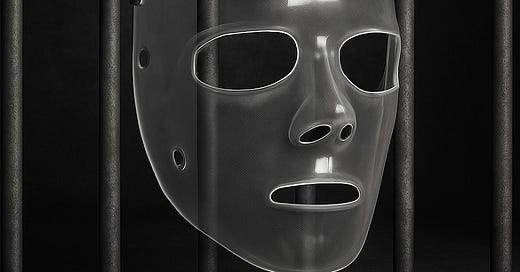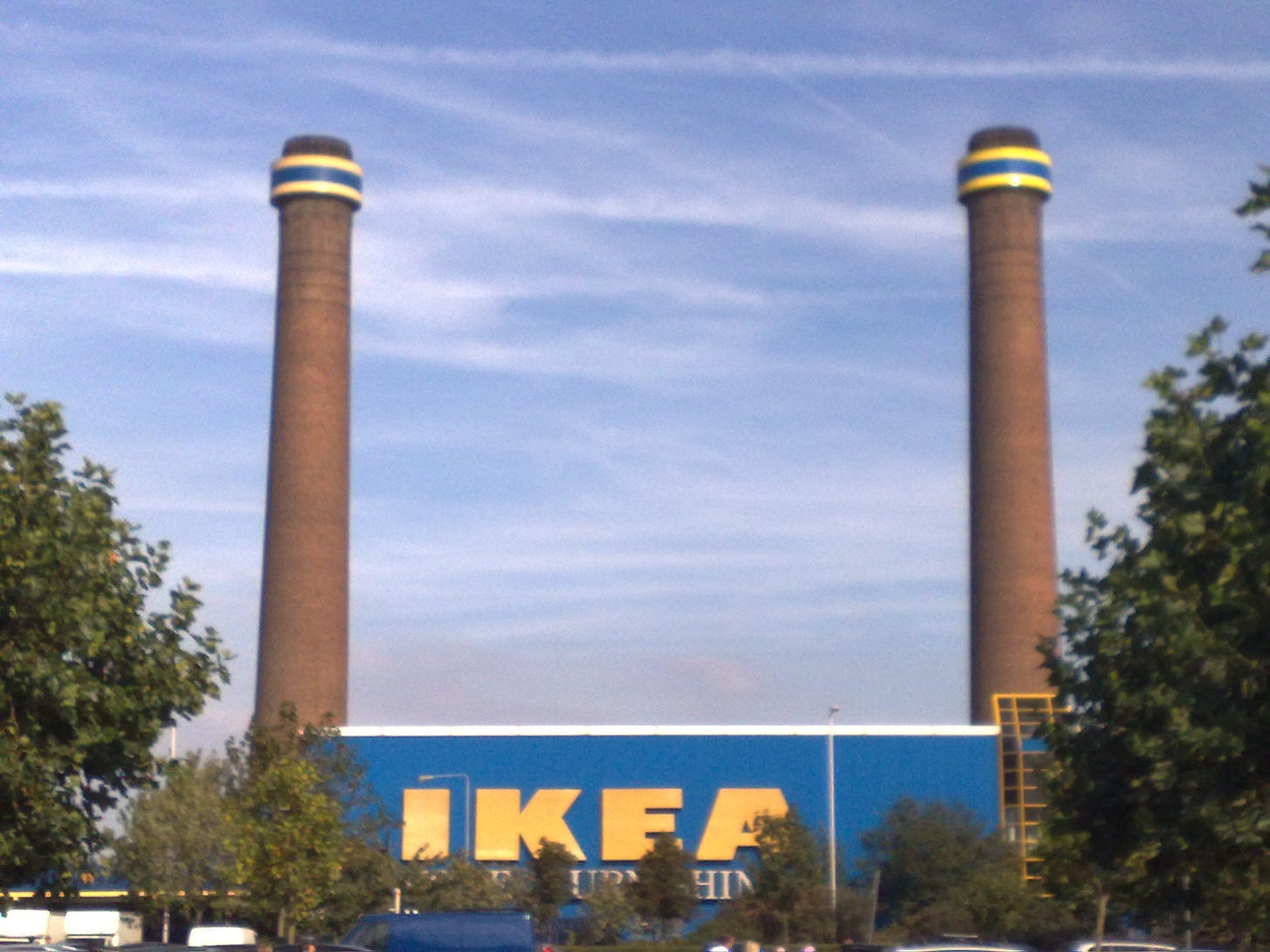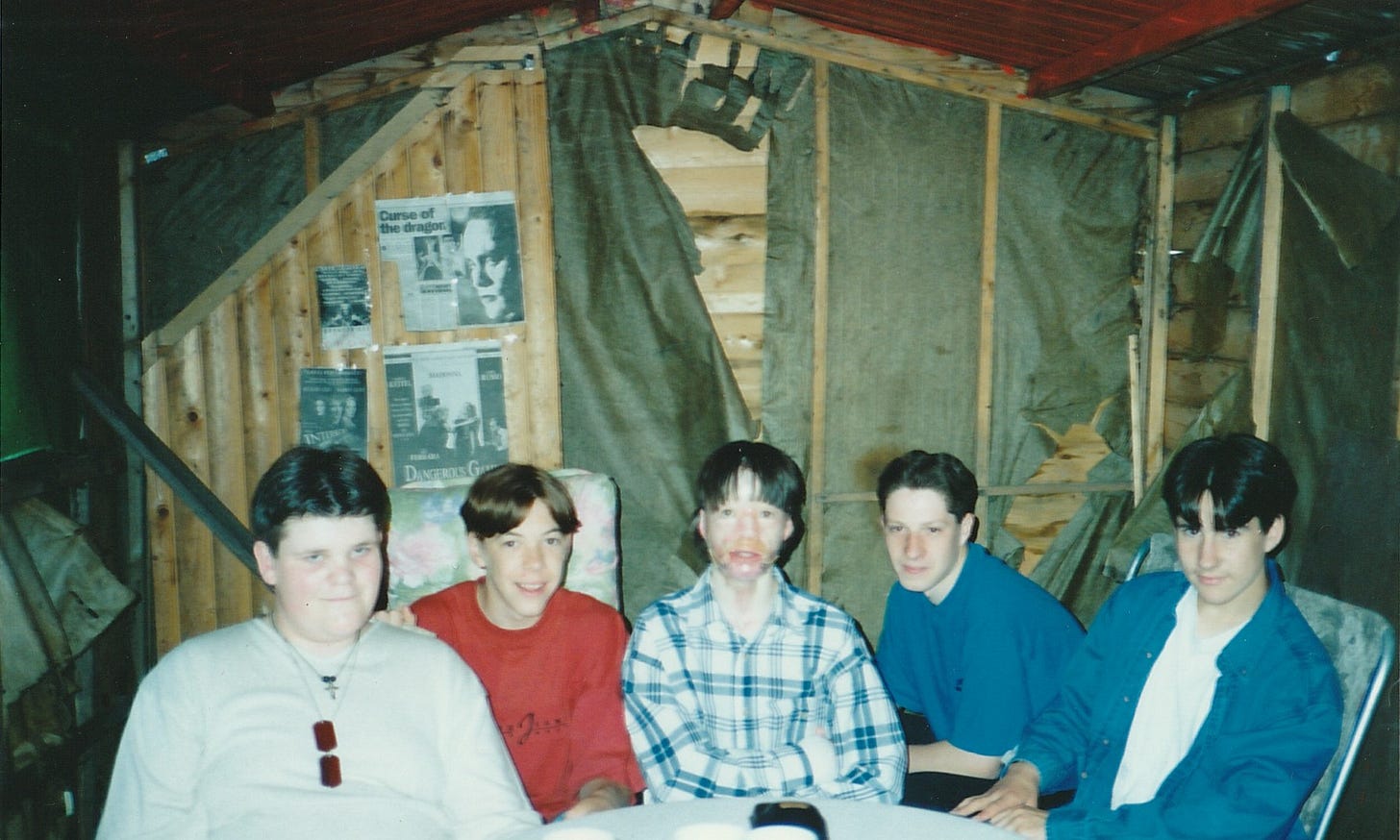Post 38. A sentence within a sentence?
Getting back out there—with a splint and a support crew
Life can be impossibly hard—but if we can find meaning in the mess, we stand a chance of becoming someone stronger than we ever imagined.
Hello darkness my old friend (similar to the rigid splint I wore at night)
In a talk I was delivering to some young folk not long ago, I described the two years I wore a face splint as like serving a prison sentence inside a prison sentence. It wasn’t planned—I just said it—and I noticed a woman in the audience nod, lips pressed together in a knowing kind of empathy. I immediately regretted saying it as it was only half true.
Yes, the splint was a sentence. It dictated how I slept, how I ate, how I moved through the world. The only thing determining my release date was my skin—if it behaved, my doctor Mark Cutler might let me out early. If not, the sentence extended. No charm, no wit, no good behaviour would change that.
But my life wasn’t a prison. In fact, in some ways (as my physio Claire said to me), the accident set me free.
That might sound odd, but it was through recovery that I began to shed the need to perform—to show up differently depending on who was watching: teachers, parents, mates, etc. Like many teenagers, I had been adjusting the volume on who I was for different audiences, wearing forms of masks (splints) long before I ever wore a literal one. It’s understandable and a handy tool to employ, but if we keep those masks on too long, we either burn out—or disappear behind them.
The change in my appearance meant I could no longer live outside-in. I had to start living from the inside-out. At fourteen, I wouldn’t have made that choice. But looking back, I can see it for the gift that it was.
Re-entry
My first face splint was fitted in November 1992, just over three months after the fire. Remarkably, it was also around the time I became an outpatient. Compared to other burn survivors I’ve read about, some of whom remained inpatients for 6-18 months, that feels incredibly fast. I credit a perfect storm: unwavering family support, brilliant friends, pioneering medical teams, and a care system that (at the time) worked together under one roof and out into the community.
My first public outing was to Ikea. Busy enough to feel like a challenge, but unlikely we’d bump into someone we knew. It felt like the right place to start.
The more vivid memory came whilst shopping in Croydon. Mum and I were standing outside Boots in the Whitgift Centre, our family’s usual meet up spot. A neighbourhood friend —Richard Shepka—came over. “You remember Marc, don’t you?” Mum said. Slightly awkward, but what else do you say in a moment like that?
Afterward I told Mum I found it tough—but truthfully, I remember thinking, Actually, that could’ve been worse. I don’t know why I said it was hard. Maybe I just thought that’s what I was supposed to say. But inside, I was thinking, I’m going to be okay.
Church was harder.
Everyone knew who I was. My recovery had been a weekly feature in the newsletter. We sat upstairs at the back, but to receive communion I had to walk down the centre aisle. I could feel the looks—curious, caring, awkward—burning into me. It wasn’t easy, but I understood it. This community had wrapped itself around us. Maybe I owed it to them to let them see how far I’d come.
Protected by Friendship
The feeling of safety was everything.
I felt safe at home. I felt safe with my friends.
You’ve met Brendan Hennessy in a previous post. He was part of my core group alongside Will Clifford and Stuart Hands. Will was steady and calm when he came to visit—that was his personality and just what I needed from him. Brendan was more emotional and energetic. Their contrast worked; they gave me balance.
There are very few photos of me wearing the splint, but here’s me with (l-r) Stuart, Brendan, Will and schoolfriend, Steve.
Stuart went to a different school but had been part of my life since birth. Our families were close, and I often stayed at his house pre-accident. It became a vital safe haven after I came home.
I remember going round for a Sunday roast. I had my new face splint on and my (then) dominant left hand had just undergone surgery. Stuart’s family had to remove the mouthpiece so I could eat. Then they cut my food, handed me a fork rigged into a contraption strapped to my rigid right hand, and we got on with it. What could have been excruciatingly awkward wasn’t. They made it normal.
They just created an opportunity for me to take a small but important step away from my immediate family and carers.
There were days I hated the splint. Days when it felt like I was locked inside my own face—unable to show expression, or even laugh without it feeling awkward or unnatural. I missed simple things like having a satisfying yawn, or eating a meal without needing elastic bands and mouthpiece removed first. But oddly, the longer I wore it, the more I found other ways to show who I was underneath. You don’t need full expression to make someone feel something real—you just need presence, intention, and connection. That was the emotional toll, yes—but in the end, it was also part of the gift.
Superpowers Evolve
In an earlier post, I talked about the moment I realised I could shape how others reacted to me—that a simple smile could change everything. That smile became my starting point, the opening line of every new interaction.
But when your smile is literally locked away behind a face splint, you have to get creative.
So I learned to wield what I had: my eyes, my words, my timing, my humour. My quick wit had gotten me in trouble at school before the fire—but now it became something else. A tool for connection. A bridge. A way to say I’m still me.
This part of my recovery—the splint era—was hard. But it gave me a crash course in reintegration, self-acceptance, and something resembling emotional resilience.
And if I had to do it all again? I wouldn’t ask for the restriction and uncomfortableness, but I would ask for the perspective.







Thanks again for sharing your experiences, insights, and wisdom with us, Marc. That whole thing of predicting, surmising, inferring (or whatever one wants to call it) how people judge us is something that really interests me. I suppose it varies from person to person, but I do think there are certain fundamentals that remain consistent. For example: This scares me, so I push it away; I empathise because I know this could have been me, so I want to learn more; or this challenges my worldview, so I either resist it or grow from it. It’s such a complex and revealing aspect of human nature. I suppose the challenge is to resist judging others for their judgment of us, and instead to appreciate those who genuinely benefit from the experience we offer.